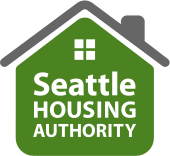Improving access to housing for the neediest people
SEATTLE—November 20, 2002—The Seattle Housing Authority will host a public hearing on Thursday, November 21, to hear from community stakeholders regarding its proposed new waiting list preferences. The housing authority plans to change the way it gives priority to applicants waiting for public housing and Section 8 voucher assistance. The new rules will give first priority to extremely low-income residents and maximize resources by integrating SHA more fully into the city’s housing continuum.
The hearing will be held from 5 p.m. to 6:30 p.m. on November 21 at SHA's PorchLight housing center, located at 907 NW Ballard Way, Suite 200. The new rules, or "waiting list preferences," will be considered by SHA’s Board of Commissioners in December.
Under the proposed waiting list preferences, first priority for housing assistance would go to all households with income at or below 30 percent of the area median. Second priority would go to all other applicants. Within the first priority group, applicants referred by recognized transitional housing programs and other service-enriched housing programs would receive first consideration.
With the new preferences, all public housing applicants would continue to be screened to ensure that they would be good tenants. In the Section 8 program, landlords are responsible for screening prospective tenants for suitability.
History of waiting list preferences
In 1988, Congress established federal preferences requiring housing authorities to give priority consideration to homeless, displaced and rent-burdened households. Households paying 50 percent or more of their income for rent are considered rent-burdened.
Then in 1998, Congress repealed those preferences and gave housing authorities two options for prioritizing applicants. Housing authorities could develop their own local preference system or continue using the government’s system of preferences. Many housing authorities chose to create their own preferences in order to better respond to local markets and eliminate problems created by federal preferences.
Waiting list preferences today
Currently, SHA’s waiting list preferences are a mix of old and new policies. At the request of local advocates, SHA chose to retain the original federal preferences in 1998 to ensure homeless applicants would continue receiving first priority status. In 2002, SHA modified its preferences so that residents of supportive housing programs and applicants referred by the Shelter Plus Care program received first priority status as well.
But the current system still creates difficulties for both the housing authority and its clients, according to Kathy Roseth, director of PorchLight, SHA’s applications and Section 8 center.
"Administering the current preferences has been extremely difficult," she said. "Too often, applicants have to make absurd choices about their circumstances to retain first priority on the waiting list. That makes the process inefficient and sometimes unfair."
For example, said Roseth, under current preferences, a family awarded first priority status due to homelessness must remain homeless for the entire waiting period – over a year, in many cases – to retain its priority status.
The new preferences are designed to eliminate that sort of conundrum and allow SHA to house more people more quickly, according to Roseth.
Because all applicants earning 30 percent of median income or less would automatically be awarded first priority under the new preferences, applicants would not have to prove that they are homeless, displaced or rent burdened in order to get and retain first priority status.
That means homeless, displaced and rent-burdened people would continue to receive first priority, since people in those groups almost always have incomes below 30 percent of the area median. But because the proposed preferences focus on income only, applicants and staff would no longer have to endure the difficult, invasive and time-consuming task of verifying personal circumstances.
Furthermore, by giving first consideration within the highest priority group to applicants from transitional and service-enriched housing programs, the new preferences would encourage households’ movement through the continuum of affordable housing in Seattle, from shelters through service-enriched transitional housing to stable, permanent housing. Awarding assistance to households that no longer need supportive environments frees up support services for those who do.
SHA will offer no more than half of available public housing units or Housing Choice Vouchers through referral agreements with providers, so that at least half of SHA’s resources will continue to be available to applicants on the general waiting list, and applicants will not have to be associated with an agency to receive assistance.
